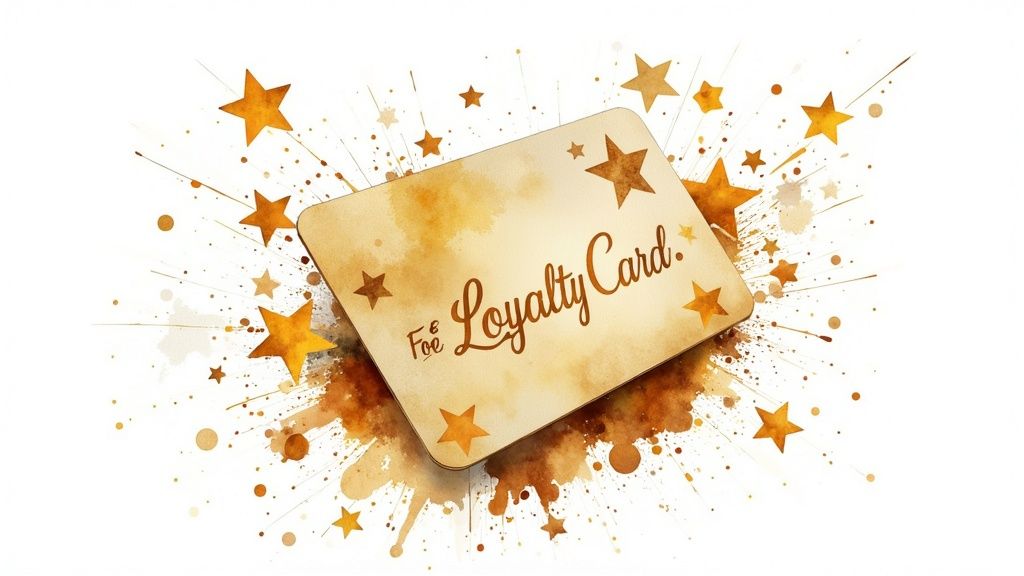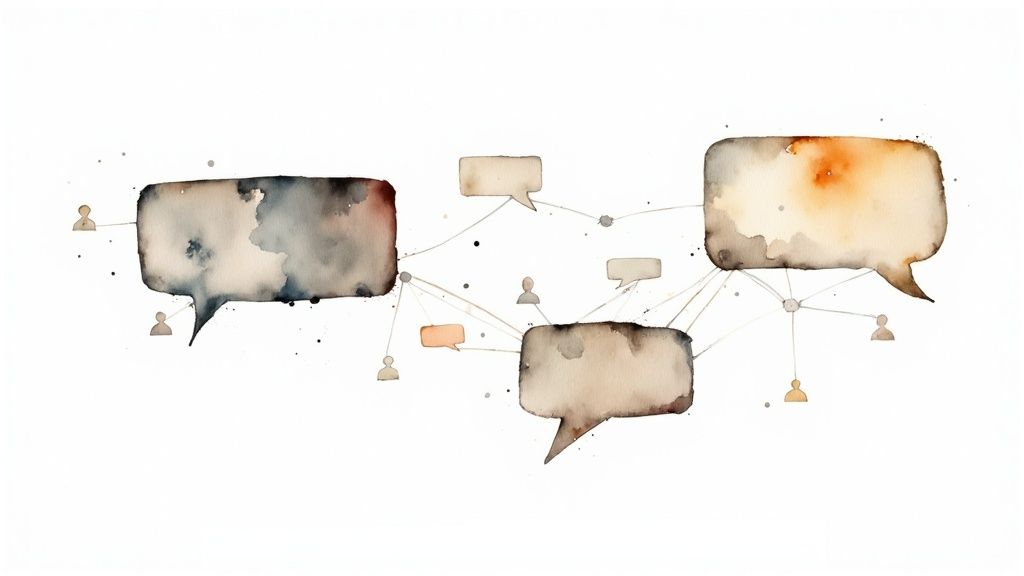Learn effective ecommerce customer retention strategies to increase loyalty and lifetime value. Implement proven tactics today!
In This Article
Subscribe to our newsletter
In the competitive landscape of online retail, acquiring a new customer can cost five times more than retaining an existing one. Yet, many brands remain fixated on a constant cycle of acquisition, overlooking the immense value locked within their current customer base. This article shifts the focus to the most critical aspect of sustainable growth: effective ecommerce customer retention strategies.
We will explore nine powerful, actionable methods that go beyond generic advice, providing you with detailed implementation plans, real-world examples, and the specific tactics needed to transform one-time buyers into lifelong brand advocates. Moving from a purely acquisition-focused mindset to one that prioritizes retention requires a deliberate shift. To truly build a retention-focused future, it's essential to understand and implement effective strategies to reduce churn rate and cultivate customer loyalty.
By implementing the strategies detailed in this guide, you can build a resilient business that thrives on repeat purchases, increases customer lifetime value, and creates a more predictable revenue stream. You will learn how to leverage everything from personalized email marketing and loyalty programs to sophisticated win-back campaigns and omnichannel experiences. Get ready to dive deep into the mechanics of building meaningful customer relationships that pay dividends long after the first purchase. This list provides the blueprint for fostering loyalty and ensuring your brand remains the preferred choice for your customers.
1. Personalized Email Marketing Campaigns
Personalized email marketing is one of the most powerful ecommerce customer retention strategies available. It involves using customer data, such as purchase history, browsing behavior, and demographics, to send highly relevant and targeted messages. This approach moves beyond generic, one-size-fits-all broadcasts and instead fosters a direct, one-to-one connection with your customers, making them feel seen and valued.

When a customer receives an email that reflects their unique interests and past interactions with your brand, it reinforces their decision to shop with you. For instance, Amazon's product recommendation engine is a prime example, suggesting items based on what a user has recently viewed or purchased. Similarly, Spotify’s annual "Wrapped" campaign creates a viral moment by giving users a personalized summary of their listening habits, strengthening brand loyalty.
How to Implement Personalized Emails
Effectively leveraging this strategy requires a thoughtful approach that combines data analysis with creative execution. By tailoring content, you can significantly increase engagement, drive repeat purchases, and reduce churn.
- Start with Segmentation: Before diving into complex personalization, group your audience into segments. You can start with basic criteria like purchase frequency (new vs. repeat customers), average order value, or product categories they've shopped from.
- Utilize Dynamic Content: Use dynamic content blocks within your email templates. This allows you to show different images, offers, or product recommendations to different segments within a single campaign, saving significant time.
- Implement Key Automated Flows: Set up essential automated emails triggered by specific customer actions. These include abandoned cart reminders, post-purchase follow-ups with related product suggestions, and "we miss you" campaigns for inactive customers.
- Test and Optimize: Continuously test different elements of your campaigns, including subject lines, send times, and the types of personalization you use. Analyze the data to understand what resonates most with your audience.
By delivering relevant content directly to a customer's inbox, you not only stay top-of-mind but also demonstrate a deep understanding of their needs, which is fundamental to building lasting relationships. To dive deeper into execution, you can explore email marketing best practices for higher engagement on project-aeon.com.
2. Loyalty and Rewards Programs
A loyalty and rewards program is a structured marketing strategy designed to encourage repeat business. It offers customers tangible incentives like points, discounts, or exclusive access in return for their continued patronage. This approach is a cornerstone of ecommerce customer retention strategies because it creates powerful financial and emotional reasons for shoppers to remain loyal, effectively building a protective moat around your customer base.

When customers feel their loyalty is recognized and rewarded, it deepens their connection to your brand. For example, Sephora's Beauty Insider program excels by offering tiered benefits, exclusive products, and a community feel that makes customers eager to climb the loyalty ladder. Similarly, the Starbucks Rewards program, integrated into its mobile app, combines points-based rewards with personalized offers, making it incredibly easy and appealing for customers to choose Starbucks over a competitor.
How to Implement a Loyalty Program
A successful program is more than just offering points; it’s about creating a value-added experience that resonates with your customers and strengthens their relationship with your brand. The key is to make it simple, valuable, and engaging.
- Make it Simple and Transparent: Ensure the rules for earning and redeeming rewards are straightforward and easy to understand. Complicated systems can deter participation. Clearly display a customer's points balance and how close they are to their next reward.
- Offer a Mix of Rewards: Go beyond simple discounts. Offer a blend of transactional rewards (e.g., free shipping, money off) and experiential benefits (e.g., early access to new products, exclusive content, or entry into a special community).
- Personalize the Experience: Use customer data to tailor reward offerings. If a customer frequently buys a specific product category, offer them bonus points or exclusive deals related to that category. Personalization makes the program feel more relevant and valuable.
- Align Benefits with Brand Values: Ensure the rewards you offer reflect what your brand stands for. If you are a sustainability-focused brand, consider offering a donation to an environmental charity as a reward option. This reinforces your brand identity and attracts like-minded customers.
By creating a well-designed rewards program, you provide a compelling reason for customers to consolidate their purchases with you, transforming one-time buyers into dedicated, long-term advocates.
3. Post-Purchase Email Sequences
Post-purchase email sequences are one of the most effective ecommerce customer retention strategies for nurturing a new buyer into a loyal advocate. This automated series of emails is sent after a customer completes a purchase, aiming to enhance their experience, provide value, and maintain engagement during the critical post-purchase period. Instead of leaving the customer in silence after the transaction, this strategy guides them, reinforces their purchase decision, and builds a bridge to their next order.

When a customer receives timely, helpful information about the product they just bought, it elevates the entire experience beyond a simple transaction. For example, Warby Parker sends styling tips after an eyewear purchase, while Casper provides content on improving sleep after a customer buys a mattress. These sequences demonstrate that your brand cares about the customer's success with the product, not just the initial sale. This proactive communication builds trust and keeps your brand top-of-mind.
How to Implement Post-Purchase Sequences
A successful post-purchase sequence turns a one-time buyer into a repeat customer by delivering value at the right moments. It's about building a relationship, not just pushing another sale.
- Time Emails Strategically: Base the timing of your emails on product delivery and usage patterns. Send a "getting started" guide right after the product arrives, not a week later.
- Provide Value Beyond Promotions: Include helpful content that educates the customer. Think tutorials, care instructions, or complementary product suggestions. For instance, a beauty brand like Glossier could send skincare routine guidance.
- Personalize Based on Products: Tailor the content of the sequence to the specific item or category the customer purchased. This shows you're paying attention to their individual needs and interests.
- Request Feedback and Reviews: A few days or weeks after the product is delivered, ask for a review. This not only provides you with valuable social proof but also makes the customer feel heard.
By maintaining a helpful and relevant dialogue after the sale, you solidify the customer relationship, making them significantly more likely to return for future purchases.
4. Subscription and Membership Models
Implementing a subscription or membership model is a powerful strategy for transforming one-time buyers into loyal, long-term customers. This approach creates an ongoing relationship through recurring payments for products or services, fostering retention by delivering continuous value and convenience. It effectively builds predictable revenue streams while cementing customer loyalty by making your brand an integral part of their routine.

This model shifts the focus from single transactions to sustained engagement. For instance, Dollar Shave Club disrupted the grooming industry by offering convenient razor subscriptions, eliminating the need for customers to remember to restock. Similarly, Birchbox popularized the discovery model with its monthly beauty boxes, providing a curated experience that keeps subscribers excited. These models succeed by integrating convenience, value, and a touch of exclusivity.
How to Implement Subscription Models
A successful subscription program requires more than just offering recurring delivery; it must provide a compelling reason for customers to commit. By focusing on the experience and benefits, you can create a model that customers won't want to leave.
- Focus on the Value Proposition: Clearly communicate the benefits beyond just the product. Is it convenience (auto-replenishment), discovery (curated boxes), or exclusive access (members-only content)? This value is key to long-term commitment.
- Offer Flexibility and Control: Allow customers to easily pause, skip a delivery, or cancel their subscription. A difficult cancellation process creates frustration and damages brand perception, while flexibility builds trust.
- Provide Exclusive Perks: Reward subscribers with unique benefits unavailable to other customers. This could include early access to new products, members-only discounts, exclusive content, or access to a private community.
- Monitor Churn and Engage: Keep a close eye on your churn rate (the percentage of subscribers who cancel). Proactively engage at-risk customers with special offers or reminders of the value they receive to prevent them from leaving.
By creating a subscription or membership, you are not just selling a product; you are offering a service that simplifies a customer’s life or enriches their experience. This makes it one of the most effective ecommerce customer retention strategies for building a loyal and predictable customer base.
5. Excellent Customer Service and Support
Providing excellent customer service and support is a foundational ecommerce customer retention strategy that builds trust and loyalty through positive human interactions. It moves beyond simply solving problems and aims to create memorable experiences that make customers feel heard, respected, and valued. This comprehensive approach ensures that every touchpoint, from pre-sale inquiries to post-purchase support, is handled with care and efficiency.
When a customer has a positive service experience, especially when resolving an issue, it can transform a potentially negative situation into a powerful moment of brand loyalty. Chewy, for instance, is famous for its empathetic support, which includes sending handwritten cards and even flowers to customers whose pets have passed away. Similarly, Zappos built its entire brand reputation on legendary 24/7 customer service and a generous return policy, proving that superior support can be a primary business driver.
How to Implement Excellent Customer Service
Delivering consistently high-quality service requires a company-wide commitment, robust systems, and an empowered team. By investing in your support infrastructure, you turn a cost center into a powerful retention engine.
- Empower Your Support Team: Give your agents the autonomy to resolve issues without needing multiple approvals. Empowered staff, like those at Ritz-Carlton, can make on-the-spot decisions to satisfy customers, leading to faster and more effective resolutions.
- Invest in Comprehensive Training: Train your team not just on products and policies, but also on soft skills like empathy, active listening, and de-escalation. A well-trained team is better equipped to handle any customer interaction with confidence and professionalism.
- Implement Customer Feedback Loops: Actively solicit feedback through post-interaction surveys (like NPS or CSAT) and use that data to identify pain points and areas for improvement. This shows customers you value their opinion and are committed to getting better.
- Use Technology to Enhance, Not Replace: Leverage tools like chatbots and AI for instant answers to common questions, but always provide an easy and clear path to a human agent. Technology should streamline processes, freeing up your team to handle more complex issues where a human touch is essential.
By prioritizing exceptional service, you create brand advocates who are more likely to make repeat purchases and recommend you to others. This people-first approach is one of the most reliable ecommerce customer retention strategies for building a loyal customer base that lasts.
6. Retargeting and Remarketing Campaigns
Retargeting is a powerful digital marketing strategy that focuses on re-engaging customers who have previously interacted with your brand but did not make a purchase. By using tracking pixels and cookies, you can serve personalized ads to these high-intent users across various platforms like social media and other websites they browse. This approach keeps your brand top-of-mind and provides a gentle nudge, encouraging them to return and complete their transaction.
This strategy is one of the most effective ecommerce customer retention strategies because it targets a warm audience already familiar with your products. For example, Facebook's dynamic product ads can showcase the exact items a user viewed or added to their cart, creating a highly relevant and personalized ad experience. Similarly, Google's remarketing campaigns can display your ads across its vast Display Network, reminding potential customers of what they left behind.
How to Implement Retargeting and Remarketing
A successful retargeting campaign requires more than just showing the same ad repeatedly. It involves strategic segmentation, compelling creative, and careful management to guide users back to your store without causing ad fatigue.
- Segment Your Audience: Group users based on their on-site behavior. Create separate audiences for homepage visitors, product page viewers, and cart abandoners. This allows you to tailor your ad messaging to match their level of intent.
- Create Compelling Ad Creative: Your ads should address potential objections or reinforce value. For cart abandoners, consider an ad that highlights free shipping or showcases a customer review for the product they considered.
- Use Sequential Messaging: Guide users through a narrative. Your first ad might be a simple reminder, the second could feature a testimonial, and a third might present a limited-time offer to create urgency.
- Set Frequency Caps: To avoid annoying potential customers, set a limit on how many times an individual sees your ad within a specific period. This prevents ad fatigue and protects your brand perception.
By strategically re-engaging users who have shown interest, you can significantly boost your conversion rates and turn missed opportunities into loyal customers. To optimize your entire funnel, you can explore various ecommerce conversion rate optimization tactics on project-aeon.com.
7. Social media community building
Social media community building is a powerful ecommerce customer retention strategy that transforms your brand's online presence from a simple broadcast channel into an interactive hub. It involves creating engaged online communities on platforms where your customers already spend their time. This approach fosters a sense of belonging, encourages peer-to-peer support, and turns satisfied customers into vocal brand advocates.
When customers feel like they are part of an exclusive group, their loyalty deepens. For example, Peloton has built a massive community around shared fitness goals, with members using leaderboards and social groups to motivate each other. Similarly, Sephora's Beauty Insider Community provides a forum for users to share tutorials, product reviews, and advice, creating immense value beyond just selling products. These communities make the brand an integral part of the customer's lifestyle.
How to Build a Social Media Community
Creating a thriving community requires a commitment to authentic engagement and value creation, not just self-promotion. By nurturing a space where customers can connect, you build an emotional investment that traditional marketing cannot replicate.
- Focus on Value, Not Sales: Your community should be a resource. Share tips, host Q&A sessions with experts, or provide exclusive behind-the-scenes content. The goal is to make membership rewarding in itself.
- Encourage User-Generated Content (UGC): Actively prompt members to share their own photos, videos, and stories using your products. Feature the best submissions on your main feed to make members feel seen and celebrated.
- Be Responsive and Authentic: Engage in conversations promptly and genuinely. Answer questions, acknowledge feedback (both positive and negative), and participate in discussions to show there are real people behind the brand.
- Create Exclusive Experiences: Offer community-only perks like early access to sales, special discounts, or invitations to virtual or in-person events. This reinforces the value of being part of the group.
By building a strong community, you create a loyal base that not only continues to buy from you but also actively recruits new customers on your behalf. To discover more ways to foster these connections, you can explore proven audience engagement techniques on project-aeon.com.
8. Omnichannel Customer Experience
Creating an omnichannel customer experience is a cornerstone of modern ecommerce customer retention strategies. This approach involves integrating all customer touchpoints, such as your website, mobile app, social media, email, and physical stores, to provide a seamless and unified journey. Unlike a multichannel approach where channels operate in silos, an omnichannel strategy ensures that a customer's experience is consistent and interconnected, regardless of how they choose to interact with your brand.
A powerful example of this is Starbucks, where customers can order and pay via a mobile app, earn rewards, and pick up their drink in-store without missing a beat. The app, in-store experience, and rewards program are all tightly integrated, creating a frictionless loop that encourages repeat business. Similarly, Target’s "buy online, pick up in-store" (BOPIS) service allows customers to shop on their website and collect their items from a local store, often within hours, blending digital convenience with physical immediacy.
How to Implement an Omnichannel Experience
Building a true omnichannel environment requires a deep commitment to customer-centricity and technological integration. The goal is to make the transition between channels so smooth that the customer doesn't even notice it, reinforcing their loyalty through sheer convenience and consistency.
- Map the Customer Journey: Begin by identifying every possible touchpoint a customer has with your brand. Understanding how they move between channels will reveal friction points and opportunities for better integration.
- Invest in a Unified Data Platform: A Customer Data Platform (CD chhoti-moti) is crucial. It centralizes customer information from all channels, creating a single, 360-degree view that allows for personalized and context-aware interactions.
- Ensure Brand Consistency: Your brand's voice, visuals, and overall experience must be consistent across every channel. A customer should feel they are interacting with the same company whether they are on your app, in your store, or talking to a support agent.
- Train Your Team: Equip your staff, especially customer service and in-store associates, with the tools and training needed to support an omnichannel journey. They should be able to access customer history and assist with cross-channel issues, like processing an online return in-store.
By breaking down the barriers between your sales and communication channels, you create a holistic brand world that customers find easy and rewarding to engage with. This level of integration not only improves satisfaction but also builds the kind of deep-seated loyalty that turns one-time buyers into lifelong advocates.
9. Win-Back Campaigns for Inactive Customers
A win-back campaign is a powerful ecommerce customer retention strategy specifically designed to re-engage customers who have become inactive. This involves identifying users who haven't purchased or interacted with your brand for a defined period and sending them targeted communications with compelling incentives to return. Instead of letting valuable past customers slip away, this proactive approach reminds them of your brand’s value and gives them a reason to come back.
When executed well, a win-back campaign can be far more cost-effective than acquiring a new customer. Food delivery services like Grubhub excel at this, sending "We miss you" emails with exclusive discounts on restaurants the user previously ordered from. Similarly, Uber often sends ride credits and special promotions to dormant users to encourage them to take another trip, effectively restarting their engagement cycle.
How to Implement a Win-Back Campaign
A successful win-back strategy requires a mix of data-driven segmentation and persuasive messaging. The goal is to make the customer feel missed, not just marketed to, which can reignite their loyalty and drive immediate sales.
- Segment Your Inactive Customers: Group dormant customers based on their past behavior. You can segment by their last purchase date (e.g., 60, 90, or 180 days inactive), their lifetime value, or the product categories they previously shopped from. This allows you to tailor your offers more effectively.
- Test Different Incentives and Messaging: Experiment with various offers to see what resonates. Some segments might respond best to a percentage discount, while others may prefer a fixed-dollar amount off or a free gift with their next purchase. Combine rational offers with emotional appeals, like "We've missed you!"
- Create a Multi-Step Sequence: Don't rely on a single email. Develop an automated, progressive win-back series. The first email might be a gentle reminder, the second could include a modest offer, and a third could present your best, time-sensitive deal as a final attempt to reactivate them.
- Monitor Post-Reactivation Behavior: Track customers who return through your campaign. Monitor their subsequent purchase frequency and value to understand if they have been successfully retained or if they require further nurturing to remain active.
By strategically reaching out to dormant customers, you can reclaim lost revenue and reinforce the customer relationships you worked hard to build in the first place, making it an essential part of your retention toolkit.
Customer Retention Strategies Comparison Table
| Strategy | Implementation Complexity 🔄 | Resource Requirements ⚡ | Expected Outcomes 📊 | Ideal Use Cases 💡 | Key Advantages ⭐ |
|---|---|---|---|---|---|
| Personalized Email Marketing Campaigns | Medium-High (data management & automation) | Moderate (CRM integration, content creation) | High customer engagement and ROI | E-commerce, retail, brands with rich customer data | Highly targeted, scalable automation, measurable ROI |
| Loyalty and Rewards Programs | High (program design & ongoing management) | High (platforms, maintenance, customer support) | Increased retention & emotional brand attachment | Retail, subscription services, customer-centric brands | Boosts lifetime value, creates differentiation, gamifies engagement |
| Post-Purchase Email Sequences | Medium (automation sequencing & content) | Moderate (content creation, automation tools) | Reduced buyer remorse, increased repeat sales | E-commerce, product-based businesses | Enhances satisfaction, drives upsell, builds relationships |
| Subscription and Membership Models | High (billing systems & logistics) | High (platform development, customer service) | Predictable recurring revenue & loyalty | Digital services, consumables, SaaS | Recurring revenue, strong loyalty, valuable data insights |
| Excellent Customer Service & Support | High (staff training & multi-channel setup) | Very High (personnel, training, technology) | Strong trust, referrals, reduced churn | All industries with customer support needs | Builds trust/loyalty, differentiates brand, reduces complaints |
| Retargeting and Remarketing Campaigns | Medium-High (tracking & ad management) | Moderate-High (ad spend, technology platforms) | Higher conversions from warm audiences | E-commerce, digital marketing campaigns | Cost-effective, personalized ads, measurable ROI |
| Social Media Community Building | Medium-High (content & moderation effort) | Moderate (community managers, content creation) | Strong brand advocacy and emotional connection | Lifestyle brands, consumer products, events | Fosters loyalty, peer support, authentic marketing |
| Omnichannel Customer Experience | Very High (integration & alignment) | Very High (tech, staff training, maintenance) | Seamless experience, higher satisfaction | Retail, hospitality, multi-channel businesses | Consistent brand experience, increased sales, competitive edge |
| Win-Back Campaigns for Inactive Customers | Medium (segmentation & personalized offers) | Moderate (campaign tools, content) | Recovery of dormant customers & revenue lift | Subscription services, e-commerce, any customer base | Cost-effective, higher conversion than cold outreach |
Building a Retention-Focused Future for Your Brand
Navigating the landscape of modern ecommerce requires a fundamental shift in perspective. The strategies detailed throughout this guide, from personalized email marketing to robust social media community building, all point to a single, powerful truth: sustainable growth is not built on a constant, frantic chase for new customers. It is cultivated by methodically nurturing the relationships you already have. The most resilient and profitable brands understand that a one-time purchase is merely the beginning of a conversation, not the end of a transaction.
Mastering a comprehensive suite of ecommerce customer retention strategies is less about picking a single "magic bullet" and more about weaving a cohesive, customer-centric tapestry. Each tactic serves a distinct but interconnected purpose. A well-timed post-purchase email sequence enhances the initial positive experience, which can then be amplified by an engaging loyalty program. Excellent customer service turns a potential problem into a moment of brand advocacy, while strategic win-back campaigns demonstrate that you value every customer, even those who have gone dormant. It's about creating a business ecosystem where every touchpoint is an opportunity to reinforce value and build trust.
From Strategy to System: Your Actionable Next Steps
Transitioning from understanding these concepts to implementing them requires a structured approach. Your journey toward a retention-focused future should not be a haphazard sprint but a deliberate, iterative process. Here’s a blueprint to guide your initial efforts:
Conduct a Retention Audit: Before launching new initiatives, analyze your current state. Use your analytics to identify your customer churn rate, average customer lifetime value (CLV), and repeat purchase rate. Pinpoint the specific stages in the customer journey where you are losing customers. Is it after the first purchase? After a support interaction? This data will reveal your biggest opportunities.
Prioritize Based on Impact and Effort: You cannot implement all nine strategies at once. Evaluate each one against your specific business needs and resources. A small brand might find immediate value in perfecting its post-purchase email sequence and building a community on a single social platform. A larger enterprise may have the resources to launch a sophisticated omnichannel experience or a complex membership model. Choose one or two high-impact, low-effort strategies to start, build momentum, and then expand.
Establish Clear Metrics for Success: For each strategy you implement, define what success looks like. For a loyalty program, it might be an increase in repeat purchase frequency. For a win-back campaign, it could be a specific reactivation rate. Attaching clear, measurable Key Performance Indicators (KPIs) to your ecommerce customer retention strategies is non-negotiable for proving ROI and making data-driven adjustments.
The End Goal: Creating Brand Champions
Ultimately, the value of a strong retention framework extends far beyond simple repeat sales. When you consistently deliver exceptional value and memorable experiences, you transform satisfied customers into loyal brand advocates. These are the individuals who not only choose you over competitors but also actively recommend your brand to their networks, write glowing reviews, and defend you online. They become an invaluable, organic extension of your marketing team, creating a powerful flywheel of growth that acquisition-focused strategies alone can never replicate.
The journey to retention mastery is ongoing. As consumer expectations evolve and new technologies emerge, your approach must adapt. To continuously build a future geared towards retention, further exploring proven ecommerce customer retention strategies can provide a wealth of actionable insights. Remember that every email sent, every support ticket answered, and every loyalty point awarded is an investment in the long-term health and profitability of your brand. By committing to this customer-centric philosophy, you are not just selling products; you are building a legacy.
Ready to turn your retention strategies into a seamless, automated system? Aeon provides the advanced tools you need to manage publisher content, optimize partnerships, and track performance across your entire digital ecosystem. Streamline your operations and focus on building lasting customer relationships by visiting Aeon to see how our platform can empower your growth.


.jpg)